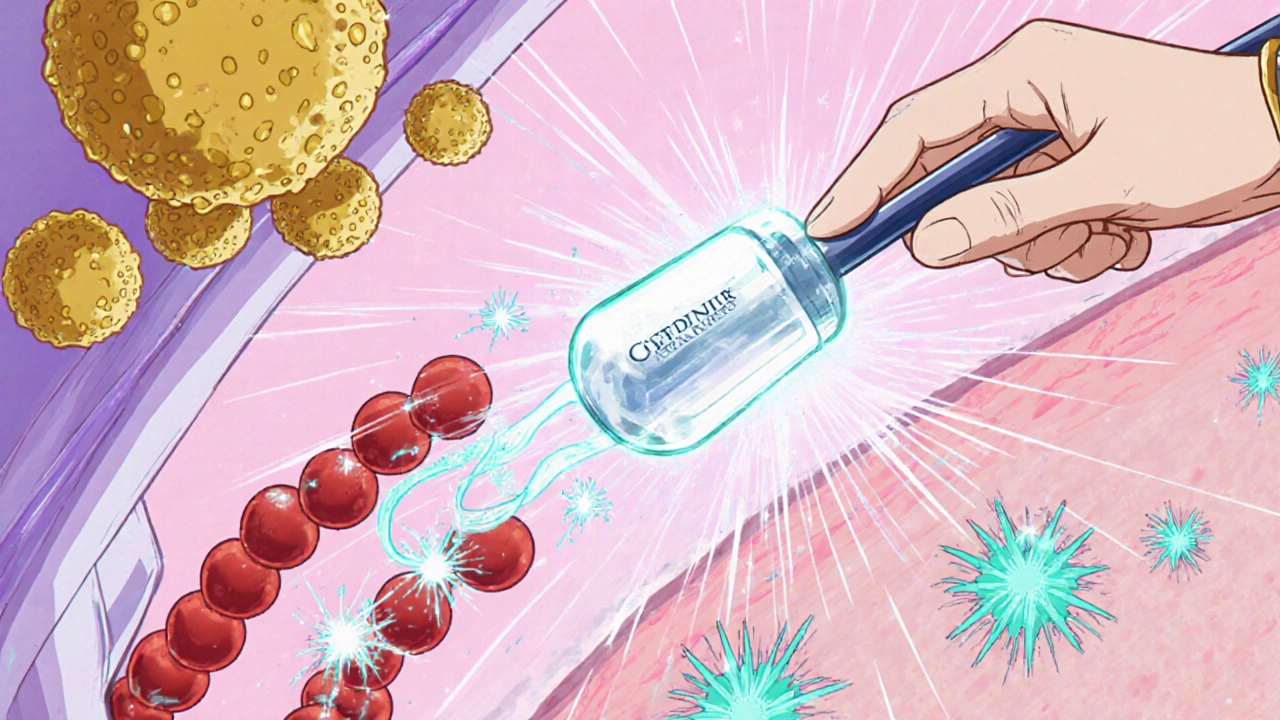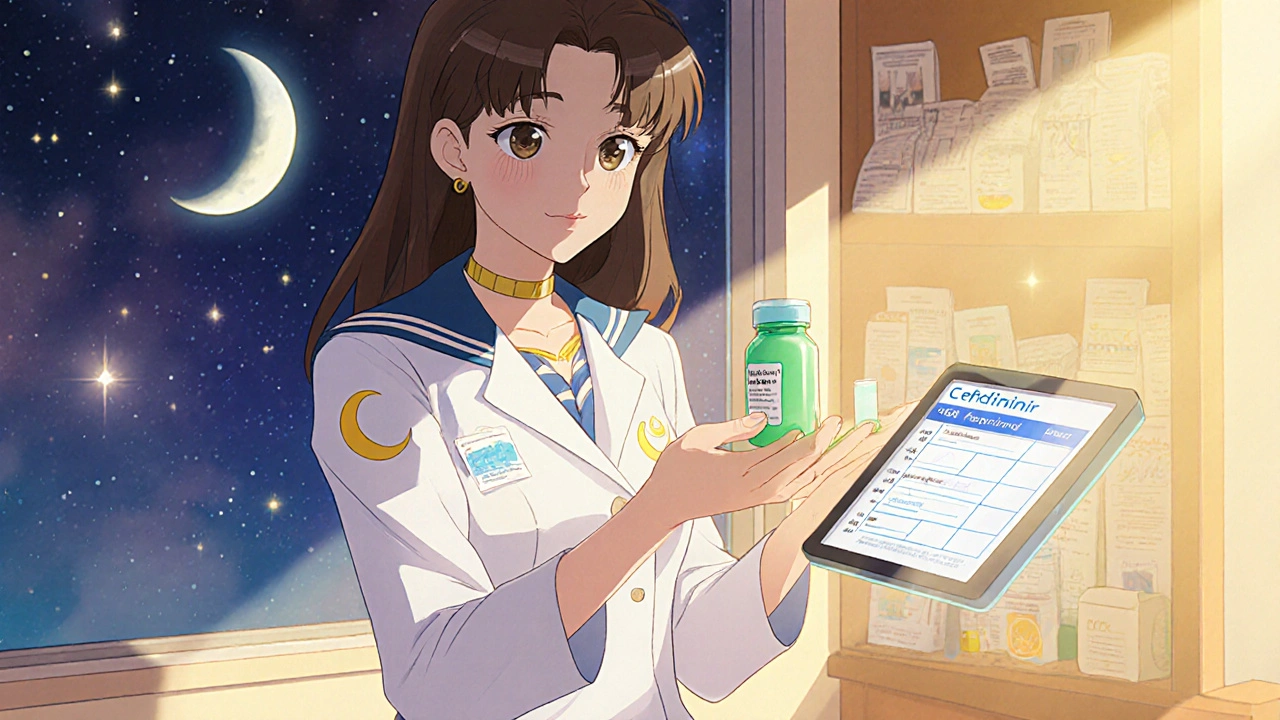Cefdinir Dosage Calculator
Cefdinir is commonly used for skin infections like impetigo, cellulitis, and erysipelas. For most adults, the standard dose is 300 mg every 12 hours for 7-10 days. For children, dosage is typically calculated by weight.
Key Dosage Guidelines
Adults (18+ years): 300 mg every 12 hours for 7-10 days
Children (6 months+): 7 mg/kg/day divided into two doses
Enter your age group and weight to see recommended dosage.
Imagine waking up with a red, painful patch on your arm that’s getting bigger by the hour. You’ve tried a home remedy, but the swelling won’t quit. That’s the moment many people wonder if an oral antibiotic can step in and stop the spread. Cefdinir is a third‑generation cephalosporin that targets gram‑positive and some gram‑negative bacteria, and it’s a go‑to option for many skin‑related infections.
What Exactly Is Cefdinir?
Cefdinir belongs to the cephalosporin family, a class of antibiotics discovered in the 1940s. Chemically, it’s a β‑lactam drug, meaning it contains a four‑membered ring that interferes with bacterial cell‑wall synthesis. When the wall can’t form properly, the bacteria burst and die. Because of its structure, Cefdinir is stable against many common β‑lactamases, the enzymes some bacteria use to neutralize older penicillins.
How Does It Work Against Skin Bacteria?
The skin’s favorite culprits are Staphylococcus aureus (often methicillin‑sensitive) and Streptococcus pyogenes. Both rely on a robust cell wall to survive. Cefdinir binds to the penicillin‑binding proteins (PBPs) inside these microbes, halting the final steps of wall construction. In a matter of hours, the bacteria lose integrity, and the infection’s spread slows dramatically. That’s why doctors can sometimes clear up cellulitis or impetigo with a short, oral course.
Skin Infections That Respond Well to Cefdinir
Skin infections are any bacterial invasions of the epidermis, dermis, or subcutaneous tissue that cause redness, swelling, pain, or pus. The most common ones treated with Cefdinir include:
- Impetigo - a contagious, superficial infection that usually appears as honey‑colored crusts on the face or extremities.
- Cellulitis - a deeper infection that makes large, warm, red patches, often on the legs.
- Erysipelas - a more sharply defined form of cellulitis, usually caused by Streptococcus.
- Folliculitis - inflammation of hair follicles that can turn into pustules.
When cultures show methicillin‑sensitive S. aureus or S. pyogenes, Cefdinir typically clears the infection in 5‑7 days.

Dosage Guidelines for Adults and Children
Getting the dose right matters for both effectiveness and minimizing side effects. Below is a quick reference that most clinicians use.
| Patient Group | Typical Dose | Frequency | Typical Duration |
|---|---|---|---|
| Adults (≥18 y) | 300 mg | Every 12 hours | 7‑10 days |
| Children 6 months‑< 12 y | 7 mg/kg | Every 12 hours | 5‑7 days |
| Children < 6 months | Not recommended unless severe | - | - |
Kid‑friendly formulations come as a sprinkle‑ready suspension, making it easy to measure out the exact milligram‑per‑kilogram dose. Always double‑check the label; some brands list 125 mg/5 mL, others 250 mg/5 mL.
How Cefdinir Stacks Up Against Other Oral Antibiotics
When a doctor decides on therapy, they often weigh Cefdinir against alternatives like dicloxacillin, clindamycin, or even a simple penicillin V. The table below highlights the main differences.
| Antibiotic | Class | Typical Spectrum | Common Dose (Adults) | Key Side Effects |
|---|---|---|---|---|
| Cefdinir | Cephalosporin (3rd gen) | Gram‑positive + some Gram‑negative | 300 mg q12h | Diarrhea, nausea, rash |
| Dicloxacillin | Penicillin | Mostly Gram‑positive (incl. MSSA) | 500 mg q6h | GI upset, allergic reactions |
| Clindamycin | Lincosamide | Gram‑positive, anaerobes | 300 mg q8h | C. difficile colitis, taste change |
| Penicillin V | Penicillin | Streptococci, some MSSA | 500 mg q6h | Allergy, GI irritation |
Notice that Cefdinir’s dosing schedule (twice a day) is often easier for patients than the three‑to‑four‑times‑daily regimens of dicloxacillin or clindamycin. That convenience can improve adherence, which is a big factor in skin‑infection cure rates.

Benefits and Drawbacks of Using Cefdinir
Pros:
- Convenient twice‑daily dosing.
- Broad enough to cover most common skin pathogens.
- Oral formulation-no injection needed.
- Generally safe for patients with mild penicillin allergies (but always check with a clinician).
Cons:
- Can cause yellow‑green stools, which looks alarming but is harmless.
- Higher cost than older penicillins in some regions.
- Not the first choice for MRSA (methicillin‑resistant _Staphylococcus aureus_).
- Potential drug‑interaction with aluminum‑ or calcium‑containing antacids, which can lower absorption.
Common Side Effects and Safety Tips
Most people tolerate Cefdinir well, but it’s good to know what to watch for:
- Gastrointestinal: mild diarrhea, nausea, or abdominal cramping.
- Rash or itching: could signal a mild allergic reaction; stop the drug if it spreads.
- Discolored stool: the drug’s metabolites can turn stool green or yellow-just tell your doctor, no need to panic.
- Rare severe reactions: anaphylaxis or severe skin blistering (Stevens‑Johnson syndrome). These are uncommon but require immediate medical care.
Always mention any current meds. For example, taking a proton‑pump inhibitor (like omeprazole) can mildly reduce Cefdinir levels, though most clinicians still prescribe together without issue. If you have kidney impairment, dosage may need reduction because the drug is cleared renally.

When to Call Your Doctor
Even the best antibiotic can’t fix an infection if it’s the wrong one. Call a healthcare professional if you notice:
- Fever > 101 °F (38.3 °C) that doesn’t improve after 48 hours.
- Rapidly spreading redness or swelling.
- Pain that worsens despite medication.
- Severe abdominal pain or watery diarrhea lasting more than 3 days (possible C. difficile).
- Any sign of an allergic reaction-hives, shortness of breath, swelling of lips or face.
These signals may mean you need a different drug, a longer course, or an IV therapy.
Quick Reference Checklist for Patients
- Confirm the prescription reads “Cefdinir” and note the strength (250 mg or 300 mg).
- Take with a full glass of water; food can be taken but isn’t required.
- Set a reminder for the twice‑daily schedule-morning and evening works well.
- Do not skip doses; if you miss one, take it as soon as you remember unless it’s near the next scheduled dose.
- Finish the entire course, even if the rash looks better early on.
Frequently Asked Questions
Can I use Cefdinir for a fungal skin infection?
No. Cefdinir only kills bacteria. Fungal infections need antifungals like terbinafine or clotrimazole.
Is Cefdinir safe during pregnancy?
Category B in the US, meaning animal studies showed no risk but there aren’t enough controlled studies in humans. Discuss with your OB‑GYN before starting.
How long before I see improvement?
Most patients notice reduced redness and pain within 48‑72 hours. Full healing often takes a week.
Can I take antacids with Cefdinir?
Antacids containing aluminum or magnesium can lower absorption. Space them at least two hours apart from the antibiotic.
What should I do if I miss a dose?
Take it as soon as you remember unless it’s almost time for the next dose-then skip the missed one and continue as scheduled. Don’t double up.
Is resistance to Cefdinir a concern?
Resistance can develop, especially with overuse. That’s why doctors usually reserve Cefdinir for infections that need broader coverage than a simple penicillin.
Can children under 6 months take Cefdinir?
It’s generally avoided in that age group unless the infection is severe and no safer alternative exists. Pediatric dosing is weight‑based.
Bottom line: Cefdinir is a solid, twice‑daily oral antibiotic that clears up most common bacterial skin infections quickly, provided the bug isn’t MRSA‑resistant. Knowing the right dose, spotting side effects early, and staying in touch with your clinician are the keys to a smooth recovery.


Bonnie Lin
October 23, 2025 AT 13:59Cefdinir is effective for cellulitis and impetigo. Take the full course as directed.
sara fanisha
October 27, 2025 AT 15:13Glad you covered the dosing schedule-makes it easier to stick with treatment.
Tristram Torres
October 31, 2025 AT 16:26Honestly the article drags on. Most readers just need the key points about dosage.
Abhishek Kumar
November 4, 2025 AT 17:39Looks fine.
Kajal Gupta
November 8, 2025 AT 18:53Cefdinir, a third‑generation cephalosporin, stands out for its broad coverage of gram‑positive organisms while still tackling some gram‑negative bugs. Its beta‑lactam ring makes it tough for many bacterial enzymes to inactivate, which translates to reliable activity against common skin pathogens like MSSA and Streptococcus pyogenes. When you take it twice daily, the steady plasma levels keep the bacteria on the defensive, reducing the chance of resistance developing during a short course. The convenience of a capsule or sprinkle‑ready suspension means you don’t need an IV line, which is a huge plus for outpatient care. Dosing is weight‑based for kids, so the pediatric formulas help avoid over‑ or under‑dosing, a critical factor in preventing side‑effects. Speaking of side‑effects, the most frequent are mild gastrointestinal upset and, amusingly, green‑yellow stool, which can be alarming but isn’t harmful. If you notice a rash or more severe GI symptoms, you should alert your clinician right away. Patients with a known penicillin allergy often tolerate Cefdinir, though a thorough allergy history is always warranted. Interaction wise, antacids containing aluminum or magnesium can lower absorption, so spacing them two hours apart is wise. Kidney function matters too; reduced clearance may necessitate dose adjustments in renal impairment. Cost can be higher than older penicillins, but the less frequent dosing schedule frequently improves adherence, which ultimately saves healthcare resources. For MRSA infections, Cefdinir is not first‑line, so culture results guide therapy. The drug’s safety profile in pregnancy is category B, indicating no proven risk in animal studies, but human data are limited, so a risk‑benefit discussion is essential. Overall, when prescribed appropriately, Cefdinir offers a balanced mix of efficacy, convenience, and tolerability for most uncomplicated skin infections.
James Gray
November 12, 2025 AT 20:06Thanks for the deep dive, Kajal! I definitely think your breakdown helps anyone confused. It’s cool how you highlighted the two‑daily schedule-makes life easier. Gotta remember to space antacids, as ya mentioned. Also, the tip about checking the strength on the bottle is gold. Hope folks follow it and stay healthy.
Scott Ring
November 16, 2025 AT 21:19Reading through the details really shows how important it is to follow the exact dosing and watch for side effects.
Shubhi Sahni
November 20, 2025 AT 22:33Wow, what an informative post, and thank you for laying out the pros and cons, the dosage tables, and the safety tips, all in one place! It really helps readers feel confident about using Cefdinir responsibly.
Danielle St. Marie
November 24, 2025 AT 23:46Only the best antibiotics deserve our trust 🇺🇸🚀
keerthi yeligay
November 29, 2025 AT 00:59Remember, consistency in taking the med is key-missed doses can delay healng.
Jinny Shin
December 3, 2025 AT 02:13The narrative of recovery is as theatrical as a stage play, yet grounded in science.